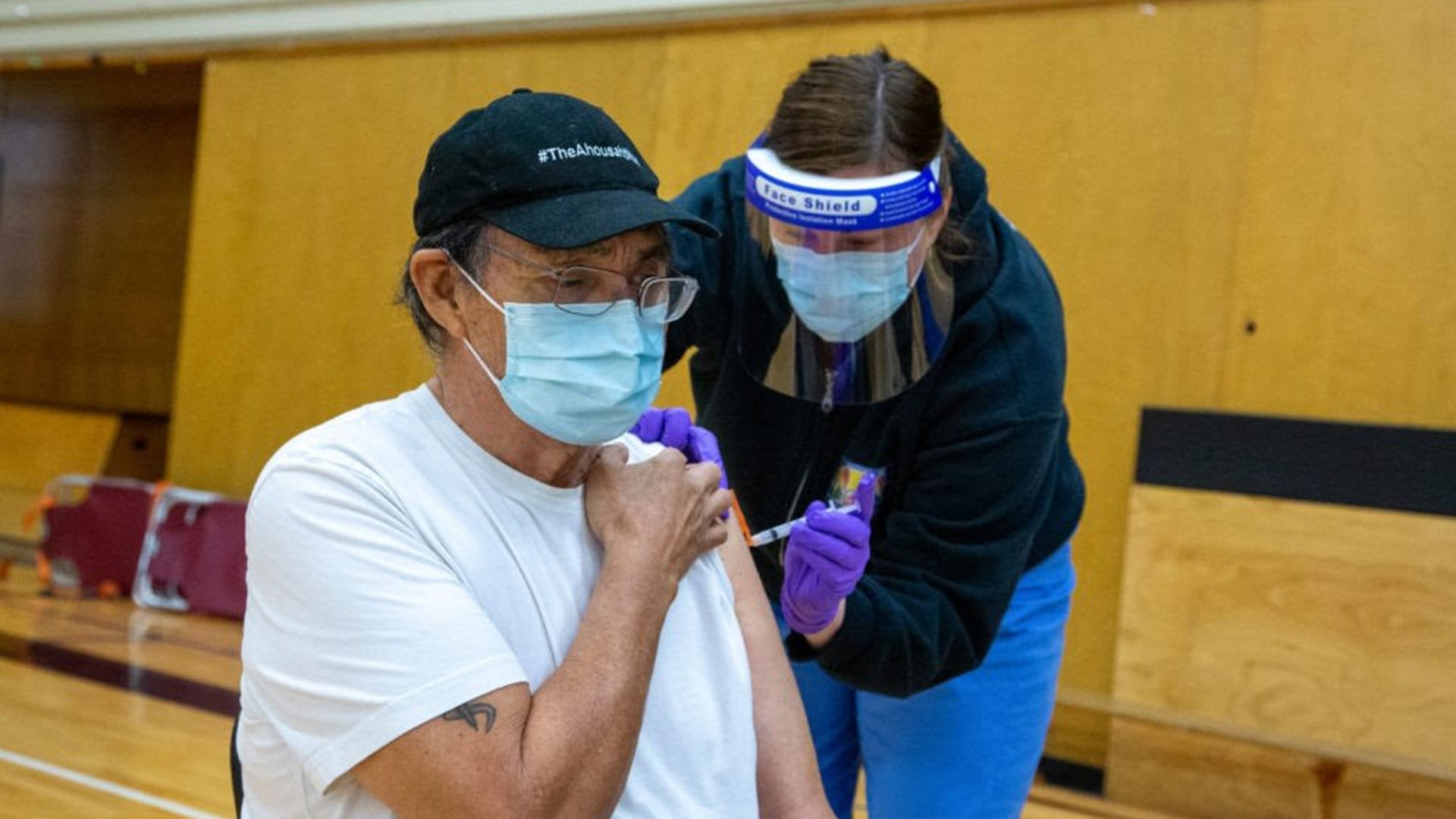
Elected Chief Greg Louie stands between Gabe Campbell and Wally Thomas (Ahousaht security), overlooking their community vaccination rollout. Photo courtesy: Courtenay Louie
During the first week of 2021, the Ahousaht First Nation saw their whole community vaccinated “the Ahousaht way.”
Cultural leaders worked alongside community members and nurses in the remote Nuu-chah-nulth community located on an island north of Tofino, off the west coast of Vancouver Island.
Chief Greg Louie says it was imperative that Ahousaht leadership provided information to community members, many of whom had questions about the vaccine and rollout process.
“We had a virtual Q&A in December with our medical health officer, Nuu-chah-nulth Tribal Council nurses and community. People could chime in and ask questions or raise concerns they may have had, and that was very helpful,” Louie tells IndigiNews.
There are reasons for what is called “vaccine hesitancy,” involving the “historical traumas from forced vaccinations in Indian residential schools and Indian hospitals, as well as ongoing widespread systemic racism in the health care system,” as outlined by Dr. Shannon McDonald, Acting Chief Medical Officer.
Dr. Shannon McDonald, acting chief medical officer, outlined possible reasons for “vaccine hesitancy” amongst Indigenous Peoples and communities, including, “historical traumas from forced vaccinations in Indian residential schools and Indian hospitals, as well as ongoing widespread systemic racism in the health care system.
“The vaccine has been found to be safe and strong, preventing 94-95 per cent of infections after two doses,” McDonald wrote in a public statement on Feb. 10, 2020. “Thirty thousand people were tested with the Moderna vaccine, and 37,796 with the Pfizer vaccine, which are the two approved for use in Canada.”
‘The Ahousaht way’
Right before Christmas, the Ahousaht First Nation received notice from the First Nations Health Authority (FNHA), informing them that the vaccine was making its way to Ahousaht. Leadership made an announcement to community members and got busy planning the rollout.
“We had our Ahousaht leadership, we had our Ha’wiih (hereditary chiefs), we had our emergency operations center director and staff, our health personnel were involved, the Nuu-chah-nulth Tribal Council nurses were involved,” Louie explains.
“It rolled out really smooth.”
When the vaccines first arrived in Ahousaht, one Ha’wiih (hereditary chief), Tlaakishwia, walked down to the dock to meet the airplane and the nurses, Louie says.
“He welcomed the nurses with the vaccine into a house. It was an awesome gesture from our hereditary chief,” he says.

The first vaccine roll-out for the Ahousaht community was smooth, due to the preparation process and collaboration of nurses, leadership and community members, Chief Greg Louie says.
Ninety-two per cent of the eligible population were vaccinated Jan. 6-8.
The community is preparing for the second round of vaccinations, set to arrive Feb. 22-24. Those not vaccinated were pregnant mothers and those with adverse health issues.
Ahousaht First Nation’s website is filled with COVID-19 information, resources, and links.
It was important to provide accurate information, from reputable sources, says Louie.
He says the planning committee divided the community of about 1,000 into eight sections, and each section was called separately to the marked tents set up outside the gymnasium.
People were greeted by cultural healers, Louie says, who would brush people off with cedar, if they wanted.
After, people were welcomed into the gymnasium where they signed forms, asked lingering questions, and were given their vaccinations.
“In the waiting area we had more of our cultural people, spiritual people. If another person or community member wanted a brushing or cleansing, or was feeling anxious or nervous, they could call on the cultural people,” Louie explains.
“It was huge, and it was really important, vitally important, that this rolled out in the right way, in what we call ‘the Ahousaht way’.”
‘You could start to see the light’
In November and December, Louie says there were 18 positive COVID-19 cases in the community, which placed a great deal of emotional stress on everyone.
“The fear, the anxiety, the unknowns that it put on our community members — it was a lot to hold,” says Louie. “And some of them didn’t hold it, you know, they expressed it in many different ways.”
When the community received its first positive case in November, it went into lockdown. People were restricted from leaving. Ahousaht, accessible only by boat or plane, is already remote, and the restrictions were hard, Louie says.
Since the pandemic first took hold in March, food was brought into the community, Louie explains — basic staples, so people wouldn’t have to leave to shop.

As the community rallied around organizing the rollout, including a dry-run, Louie says he became emotional. It was a hard and long winter, he said.
“It was a relief, you could start to see the light,” Louie describes. “During the time of the vaccination, I could see the attitudes of our team and community start to lighten up.”
Every Elder over 65 was gifted a blanket, “to comfort them, warm them,” Louie says. “It was a gift from the community.”
This is the Ahousaht way, Louie explains, reflective of the community’s cultural values of respect, teaching, and caring. When it comes to sharing information and experience, the fourth value of helping others surfaced as well.
“If there’s a piece that you take out of the Ahousaht way, and you bring it into your community, that’s what we’re here for,” Louie says.
“The way we do things is, it’s not for us to keep this. If it can help somebody else, that’s what we’re here for.”










